Corsair Neutron & Neutron GTX: All Capacities Tested
by Kristian Vättö on December 19, 2012 1:10 PM ESTAnandTech Storage Bench 2011
Last year we introduced our AnandTech Storage Bench, a suite of benchmarks that took traces of real OS/application usage and played them back in a repeatable manner. Anand assembled the traces out of frustration with the majority of what we have today in terms of SSD benchmarks.
Although the AnandTech Storage Bench tests did a good job of characterizing SSD performance, they weren't stressful enough. All of the tests performed less than 10GB of reads/writes and typically involved only 4GB of writes specifically. That's not even enough exceed the spare area on most SSDs. Most canned SSD benchmarks don't even come close to writing a single gigabyte of data, but that doesn't mean that simply writing 4GB is acceptable.
Originally we kept the benchmarks short enough that they wouldn't be a burden to run (~30 minutes) but long enough that they were representative of what a power user might do with their system. Later, however, we created what we refer to as the Mother of All SSD Benchmarks (MOASB). Rather than only writing 4GB of data to the drive, this benchmark writes 106.32GB. This represents the load you'd put on a drive after nearly two weeks of constant usage. And it takes a long time to run.
1) The MOASB, officially called AnandTech Storage Bench 2011—Heavy Workload, mainly focuses on the times when your I/O activity is the highest. There is a lot of downloading and application installing that happens during the course of this test. Our thinking was that it's during application installs, file copies, downloading, and multitasking with all of this that you can really notice performance differences between drives.
2) We tried to cover as many bases as possible with the software incorporated into this test. There's a lot of photo editing in Photoshop, HTML editing in Dreamweaver, web browsing, game playing/level loading (Starcraft II and WoW are both a part of the test), as well as general use stuff (application installing, virus scanning). We included a large amount of email downloading, document creation, and editing as well. To top it all off we even use Visual Studio 2008 to build Chromium during the test.
The test has 2,168,893 read operations and 1,783,447 write operations. The IO breakdown is as follows:
| AnandTech Storage Bench 2011—Heavy Workload IO Breakdown | ||||
| IO Size | % of Total | |||
| 4KB | 28% | |||
| 16KB | 10% | |||
| 32KB | 10% | |||
| 64KB | 4% | |||
Only 42% of all operations are sequential; the rest ranges from pseudo to fully random (with most falling in the pseudo-random category). Average queue depth is 4.625 IOs, with 59% of operations taking place in an IO queue of 1.
Many of you have asked for a better way to really characterize performance. Simply looking at IOPS doesn't really say much. As a result we're going to be presenting Storage Bench 2011 data in a slightly different way. We'll have performance represented as Average MB/s, with higher numbers being better. At the same time we'll be reporting how long the SSD was busy while running this test. These disk busy graphs will show you exactly how much time was shaved off by using a faster drive vs. a slower one during the course of this test. Finally, we will also break out performance into reads, writes, and combined. The reason we do this is to help balance out the fact that this test is unusually write intensive, which can often hide the benefits of a drive with good read performance.
There's also a new light workload for 2011. This is a far more reasonable, typical every day use case benchmark. It has lots of web browsing, photo editing (but with a greater focus on photo consumption), video playback, as well as some application installs and gaming. This test isn't nearly as write intensive as the MOASB but it's still multiple times more write intensive than what we were running last year.
We don't believe that these two benchmarks alone are enough to characterize the performance of a drive, but hopefully along with the rest of our tests they will help provide a better idea. The testbed for Storage Bench 2011 has changed as well. We're now using a Sandy Bridge platform with full 6Gbps support for these tests.
AnandTech Storage Bench 2011—Heavy Workload
We'll start out by looking at average data rate throughout our new heavy workload test:
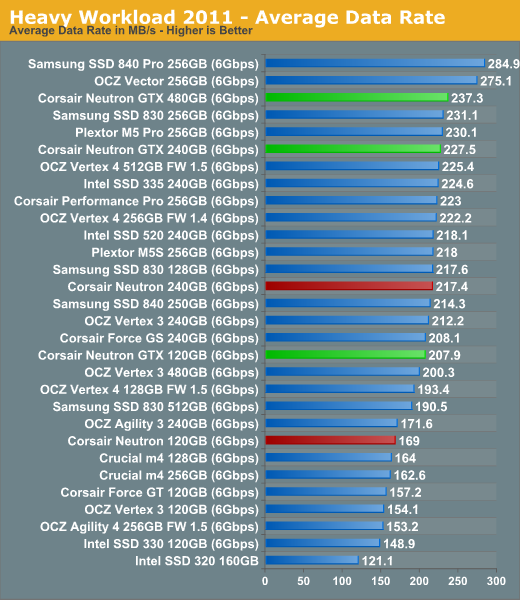
The 480GB Neutron GTX enjoys a small speed increase over the 240GB version but in general the overall performance follows the same pattern as our synthetic tests. The only truly significant difference in performance is between the 120GB models where the Neutron GTX beats the regular Neutron by 23%. Neutron GTX is actually a very high performer at 120GB although I have to note that we have not tested the 128GB version of Samsung SSD 840 Pro and OCZ Vector yet.
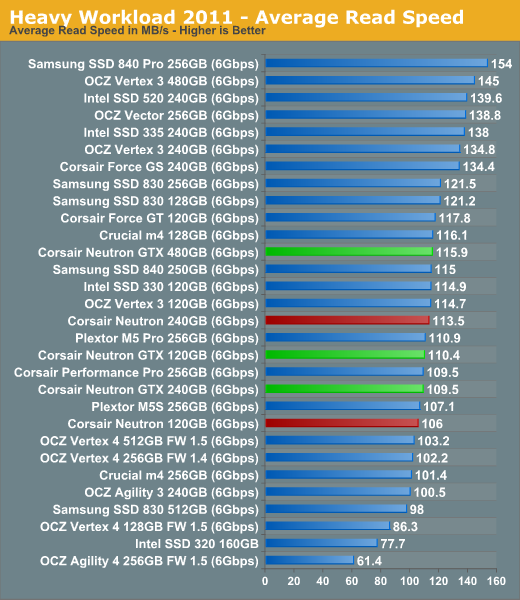
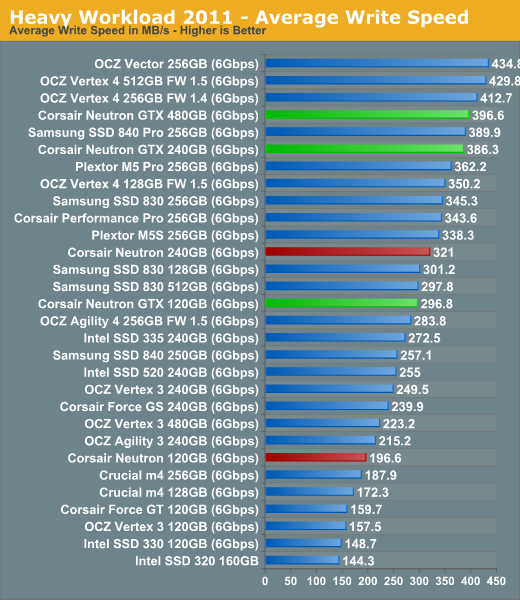
The next three charts just represent the same data, but in a different manner. Instead of looking at average data rate, we're looking at how long the disk was busy for during this entire test. Note that disk busy time excludes any and all idles, this is just how long the SSD was busy doing something:

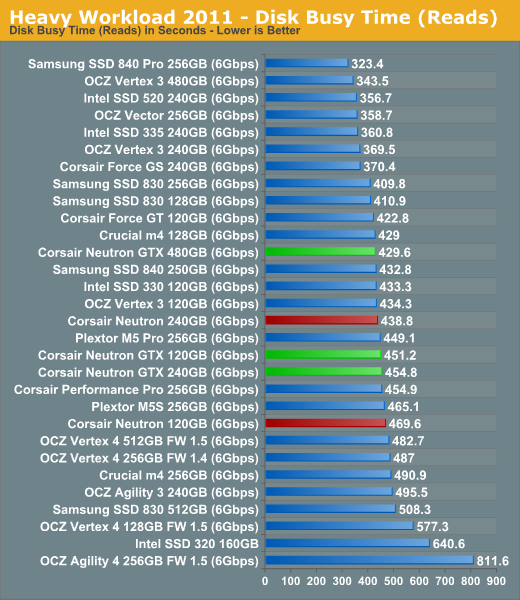
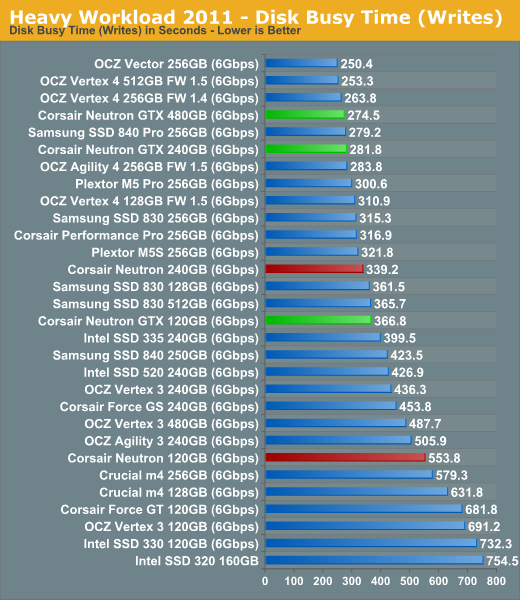










44 Comments
View All Comments
nedjinski - Wednesday, December 19, 2012 - link
I wish you could somehow get Mushkin SSD's into the mix :)Kristian Vättö - Thursday, December 20, 2012 - link
I've asked Mushkin for review samples several times but for some unknown reason, they have never sent us any. And yes, I've tried emailing them again and again but I haven't gotten any replies...Mumrik - Thursday, December 20, 2012 - link
That's weirdly worrying.AT isn't exactly a small hardware-grabbing site.
ICBM - Wednesday, December 19, 2012 - link
It was mentioned that the LAMD controller isn't in the same class as Vector/840Pro, however it seems like it only loses a couple of benchmarks. The others it is winning or just slightly behind. So is it really not up to par with OCZ and Samsung? Would the average user, heck scratch that. Would the most avid enthusiast know the difference between an 840 Pro and a Neutron GTX running in their system?Beenthere - Wednesday, December 19, 2012 - link
In actual use no one is likely to be able to tell the difference in performance between a SATA 2 drive compared to a SATA 3, let alone between the recent crop of SATA 3 SSDs.People should do their homework before jumping in to an SSD. If you chose to go forward at least you'll know which drives to definitely avoid and which ones are the cheapest. Don't assume because an SSD is a familair brand name that it is either reliable nor fully compatible because you may be in for quite a rude awakening. It's foolish to pay more based on some perceived benefit in benchmarks when it means nothing in actual use.
Denithor - Thursday, December 20, 2012 - link
This is very true.I switched from a 120GB Intel 320 (SATA 2) to a 180GB Intel 330 (SATA 3) and the only difference I could see/feel was the increased capacity of the new drive. Boot times were nearly identical, apps open at the same speeds, no discernible improvement from the upgrade.
hammer256 - Wednesday, December 19, 2012 - link
Those consistency results are pretty remarkable. From newegg reviews, however, it appears to have a bimodal distribution of 5's and 1's, but the sample size is pretty small. Still, I wonder how good their QC is...skytrench - Thursday, December 20, 2012 - link
Not really, the consistency tests on a 100% full and 100% fragmented drive with nonstop 4k random writes, doesn't reflect reality. You wouldn't even allow your ZFS filesystem to reach that state! Some better test should be devised.nushydude - Thursday, December 20, 2012 - link
which SSD to get strictly for OS, applications and games? i think Neutron GTX is too much because i won't be writing much data. a Samsung 840 should suffice? i want better performance than a 120GB Kingston HyperX (original one) btw.nathanddrews - Thursday, December 20, 2012 - link
Simple, use the light workload storage benchmarks and select any drive that performs better than your current SSD.I'll even be really nice and provide you with a link. :-)
http://www.anandtech.com/bench/SSD/269